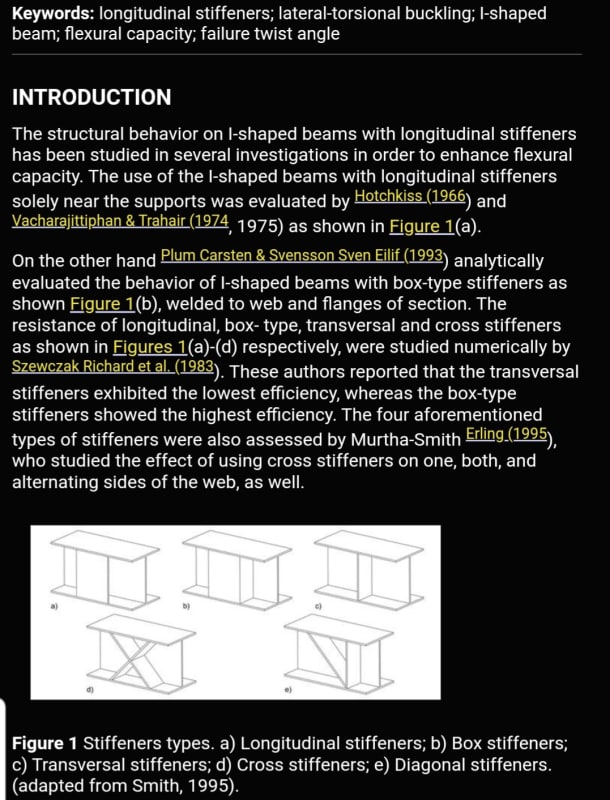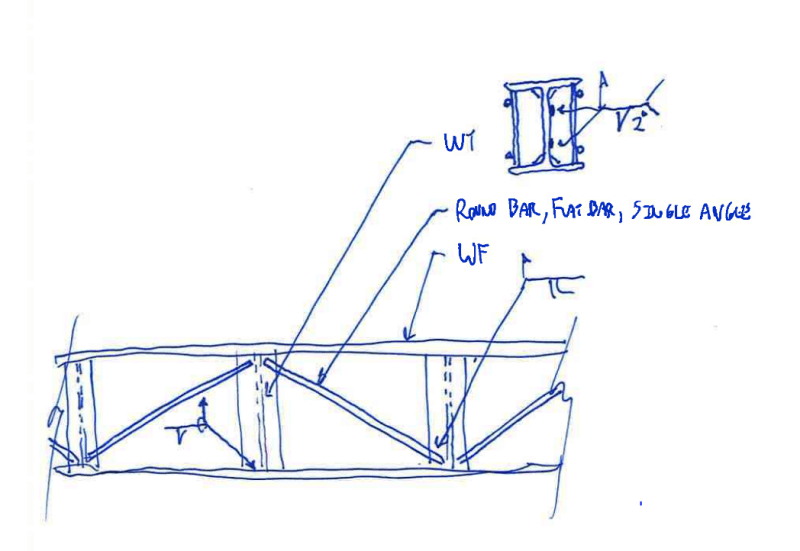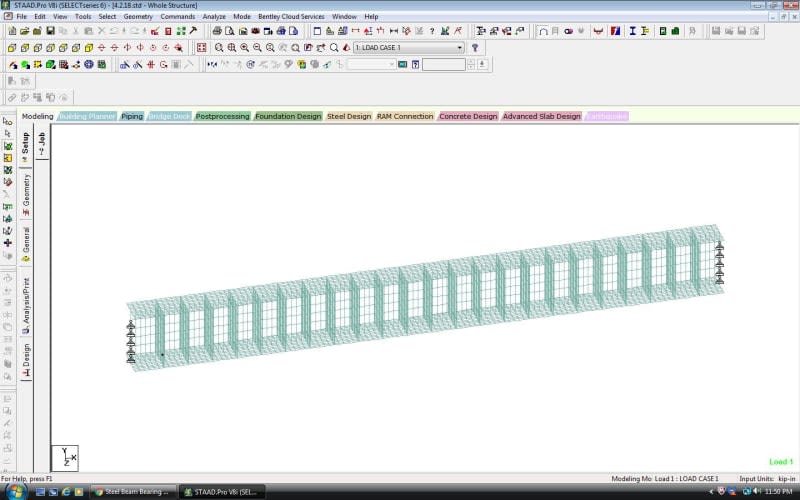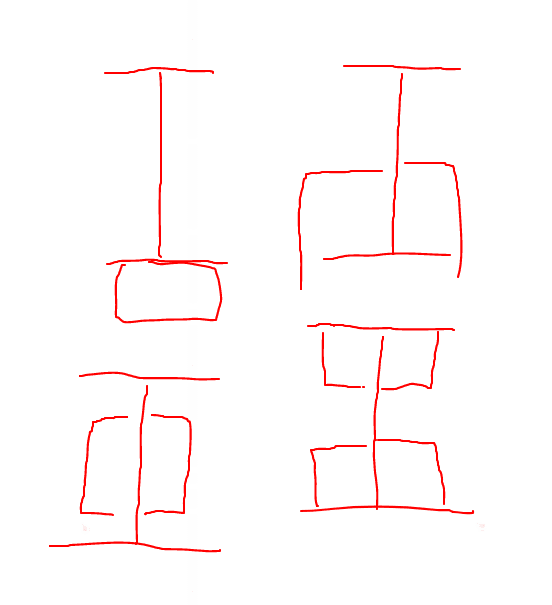Navigation
Install the app
How to install the app on iOS
Follow along with the video below to see how to install our site as a web app on your home screen.
Note: This feature may not be available in some browsers.
More options
Style variation
-
Congratulations MintJulep on being selected by the Eng-Tips community for having the most helpful posts in the forums last week. Way to Go!
You are using an out of date browser. It may not display this or other websites correctly.
You should upgrade or use an alternative browser.
You should upgrade or use an alternative browser.
Wide flange with stiffener plates against Torsion? 8
- Thread starter planc
- Start date
- Status
- Not open for further replies.
JoshPlumSE
Structural
The only time I use transverse stiffeners to stiffen a wide flange beam for torsion are when I want to:
a) Take a local load that was applied at the tip of the flange or such and make sure that load (and the torsion from it) gets into the member without local distortion of the cross section.
b) If I'm using those transverse stiffeners to brace back to a perpendicular member than can resist the torsion with its strong axis bending..... i.e. as part of a transverse moment connection.
a) Take a local load that was applied at the tip of the flange or such and make sure that load (and the torsion from it) gets into the member without local distortion of the cross section.
b) If I'm using those transverse stiffeners to brace back to a perpendicular member than can resist the torsion with its strong axis bending..... i.e. as part of a transverse moment connection.
driftLimiter
Structural
OP needs to clarify if he wants torsion reinforcement or torsion restraint. If torsion restraint is needed then adding stiffeners to the web or closing the section does not achieve that? If there is another element to connect the plates too then torsion displacement can maybe be restrained there. Otherwise all we are talking about is increasing the section properties to be stiffer against torsion? Did I miss something here?
- Thread starter
- #25
It will carry exactly 39 inches high thin 4" masonry parapet wall with uniform load of 0.144581 Kip/ft. The capacity of the beam is ten times over at 2.8 Kip/ft. Although my colleague said the torsion is enough resist them. I need torsion reinforcement to strengthen it further from twisting from more lateral load. Safety factor.
So it is torsion reinforcement I need and not torsion restrain because there was no beams framing into the sides of the member being reinforced that would interfere with the side plates. It has enough weak axis strength though. And closing the sides would even increase the weak axis strength, is it not.
-
1
- #26
driftLimiter
Structural
So you need the web stiffeners presumably to provide supports for the flange where the eccentric loading is placed. Now you use the polar moment of inertia of the beam and mechanics of materials to calculate the rotation and shear stresses due to torsion (AISC Design Guide 9). After combining the stresses with other shears in the beam if you have a failure then your needing to reinforce the section. The idea of closing the section with a longitudinal plate on each side is probably your best bet. I have a hard time believing that the beam with over 10 times capacity for the bending moment is getting such a large torque (from the same load) to fail due to additional shear from torsion.
It seems like you had been advised to place stiffeners for the purpose of supporting the flange perhaps you don't need torsion reinforcement? If that is the only case you need to resist (see above commentary) the spacing of them is based on the flexibility of the beam flange, I think most people would pick a nominal spacing that is appropriate to limit deflection of the 4" CMU above. You could treat the flange as a plate supported on (3) sides and check deflection against limits appropriate for the CMU wall.
And yes closing the sides will increase the weak axis strength but the reason it has been brought up here is to increase the torsional strength and stiffness of the section. Torsion stresses are a function of the polar moment of inertia and there are only so many ways to increase that. All of the ways will also impact your in-plane and out-of- plane strength as well it would be difficult(pretty much impossible) to uncouple these different strengths.
It seems like you had been advised to place stiffeners for the purpose of supporting the flange perhaps you don't need torsion reinforcement? If that is the only case you need to resist (see above commentary) the spacing of them is based on the flexibility of the beam flange, I think most people would pick a nominal spacing that is appropriate to limit deflection of the 4" CMU above. You could treat the flange as a plate supported on (3) sides and check deflection against limits appropriate for the CMU wall.
And yes closing the sides will increase the weak axis strength but the reason it has been brought up here is to increase the torsional strength and stiffness of the section. Torsion stresses are a function of the polar moment of inertia and there are only so many ways to increase that. All of the ways will also impact your in-plane and out-of- plane strength as well it would be difficult(pretty much impossible) to uncouple these different strengths.
- Thread starter
- #27
The 39" high 4" thin masonry parapet will be put at center of the wide flange ibeam. Not eccentric. There will be vertical reinforcement inside each masonry block welded to the top of the ibeam (think studs).
The longitudinal side plates reinforcement of the Ibeam (turning it into HSS) is to resist moments induced by wind or seismic that will sway the parapet out of plane back and forth. So what I need in your terminology is torsion reinforcement?
But you mentioned "If torsion restraint is needed then adding stiffeners to the web or closing the section doesn't not achieve that?".
Why the question mark, are you asking others or emphasizing it doesn't achieve that?
But if you close the section, it would increase the torsion strength of the beam. This can for small torsion substitute for bracing (what you mean by torsion restraint)?
- Thread starter
- #28
Yeah, the truss would work but spliced lengths of thin, continuous side plate are sure to be more practical to build. Are there no beams framing into the sides of the member being reinforced that would interfere with the side plates?
I talked to a steel company who refused to cut the 4 x 8 feet 0.4" plate into pieces small enough to cover the sides of the I shaped beam. They wanted to sell one whole piece. What tool has anyone used to cut 0.4" thick plate? Is it possible the steel company used acetylene to cut them?
Would you or someone give references on design of trusses as stiffeners for I shaped beam. I found stuff like these but not trusses stiffeners:

Also can anyone show me examples of torsion failure in I shaped beam supporting a 39" high parapet? Would the parapet masonry breaks apart before the torsion failure in Ibeam or would the Iibeam twist with wall slanting to near horizontal position before the masonry falls apart? Let us say there is 0.4" diameter rebar used in each masonry up to 39 inches.
A picture is worth a thousand words. Please show some actual photos. Appreciated any help.
centondollar
Structural
Make the section closed if you are having issues with torsion. If torsion is unlikely to occur, you probably do not need any stiffeners, since the primary purpose of a transverse and longitudinal stiffener is to prevent failure due to shear buckling of a (relatively) thin web. Stiffeners welded to the web are not usually used to restrict LTB, since they do not add much weak-axis second moment of area.
OP said:I talked to a steel company who refused to cut the 4 x 8 feet 0.4" plate into pieces small enough to cover the sides of the I shaped beam.
They refused? Even for... money? That's just weird.
planc said:What tool has anyone used to cut 0.4" thick plate?
I'll let someone else speak to the appropriate tool but, for what it's worth, I would be absolutely astounded if you needed plates larger than 1/4" for the torsion reinforcing. There's no need to match the flange thicknesses in this regard.
OP said:Would the parapet masonry breaks apart before the torsion failure in Ibeam or would the Iibeam twist with wall slanting to near horizontal position before the masonry falls apart?
A lot would depend on the masonry jointing I would think. If you had joints at each end of the beam, I suspect that the parapet probably could ride along with the beam rotation to quite an extent.
planc said:Would you or someone give references on design of trusses as stiffeners for I shaped beam.
I know of no such reference and, given how specialized the application is, I'd be surprised if anything were available in print.
If you're going the truss route, then I feel that the first step is figuring out how to construct and detail that. I've presented one option below.
As for the design of the trussed beam, I would be inclined to model the torsional properties of the assembly as a box or space truss, with the flanges represented by trusses having equivalent shear characteristics to the solid flange. As you rightly anticipated, this design exercise will be quite a bit more involved that just doing the basic checks on a built up HSS.

Where the hell are you located? And don't you have a suitable flat plate stock available? Rather than profile cutting a large plate?planc said:I talked to a steel company who refused to cut the 4 x 8 feet 0.4" plate into pieces small enough to cover the sides of the I shaped beam.
Yeah pay me and I'll cut the damn steel.kootk said:They refused? Even for... money? That's just weird.
-hydraulic cropperplanc said:What tool has anyone used to cut 0.4" thick plate?
-plasma cutter
-water cutter
-laser cutter
-hand plasma cutter
-oxy torch
-angle grinder (in a pinch)
THIS.kootk said:I'll let someone else speak to the appropriate tool but, for what it's worth, I would be absolutely astounded if you needed plates larger than 1/4" for the torsion reinforcing. There's no need to match the flange thicknesses in this regard.
Planc you are going to have to pick a solution and do some calcs. It seems that you have been skipping the second bit and jumping straight to the solution as something tells me you haven't calculated your torsion requirements let alone the torsional capacity of the member you are trying to build. 0.4" inch plate is thick for your needs.
Closing the section with plate is fine, but there are also other pretty straightforward solutions you could look at if it's causing you practical problems (for some reason).
It sounds like this isn't necessarily built yet. Can you just replace the wide flange with an HSS rectangle? If not, these two things seem like options as well.
Design the parapet to weak axis span lateral loads to the ends of the beam?
Run another beam parallel to the one that is causing you problems and run members between them periodically to resolve out the torsion as a couple moment between them.
It sounds like this isn't necessarily built yet. Can you just replace the wide flange with an HSS rectangle? If not, these two things seem like options as well.
Design the parapet to weak axis span lateral loads to the ends of the beam?
Run another beam parallel to the one that is causing you problems and run members between them periodically to resolve out the torsion as a couple moment between them.
I hate to say it but I have a bad feeling about members planc and pixy:
1) As I understand it, both members are located in the Philippines. I suspect that they are showing up as California and Ontario here as a result of VPN magic. A bit like how I show up as Denmark when I'm downloading Game of Thrones.
2) In the past we've had difficulty here with non-engineers (possibly contractors) from the Philippines misusing our forum to procure design assistance. The claim is that this has less to do with getting free advice and more to do with overcoming perceived deficiencies in the skill sets of local engineers (their words not mine). If the latter is true, then I can certainly understand the motiviation.
3) Recent threads by planc and pixy, including this one have this same feel to me. Examples: Link, Link.
I'm pretty generous with my efforts here but:
a) I don't like to be deceived.
b) I don't like this forum being misused.
c) I don't like this community having its time wasted.
@plank/pixy: if I've gotten this wrong, please do clarify the situation and forgive my skepticism. Sadly, I've been trained to it here over the years.
1) As I understand it, both members are located in the Philippines. I suspect that they are showing up as California and Ontario here as a result of VPN magic. A bit like how I show up as Denmark when I'm downloading Game of Thrones.
2) In the past we've had difficulty here with non-engineers (possibly contractors) from the Philippines misusing our forum to procure design assistance. The claim is that this has less to do with getting free advice and more to do with overcoming perceived deficiencies in the skill sets of local engineers (their words not mine). If the latter is true, then I can certainly understand the motiviation.
3) Recent threads by planc and pixy, including this one have this same feel to me. Examples: Link, Link.
I'm pretty generous with my efforts here but:
a) I don't like to be deceived.
b) I don't like this forum being misused.
c) I don't like this community having its time wasted.
@plank/pixy: if I've gotten this wrong, please do clarify the situation and forgive my skepticism. Sadly, I've been trained to it here over the years.
Kootk said:I hate to say it but I have a bad feeling about members planc and pixy.
Oh for sure. I've assumed as such for a long time. Which is why for many of the posts I don't bite and many I do wonder while people dedicate so much of their own time to them. On a few that interest me enough like this one I'll bite but I generally refrain from feeding such users. Veer I believe is another one, though at least he is partially up from about being a steel detailer well out of his depth.
You are. And I wouldn't be as generous with questions like this unless they genuinely spark an interest that your want to explore.Kootk said:I'm pretty generous with my efforts here but:
@planc/pixy;
If my concerns are valid, here's what I propose:
1) Set us straight with respect to where you are, what your role is in the projects that we discuss with you, and how you're using the advice that we provide.
2) I'll approach site management about authorizing us to help you out, above board. Our membership is obviously interested in participating in the discussions that you initiate. And I, for one, am not opposed to helping non-engineers in certain situations.
If my concerns are valid, here's what I propose:
1) Set us straight with respect to where you are, what your role is in the projects that we discuss with you, and how you're using the advice that we provide.
2) I'll approach site management about authorizing us to help you out, above board. Our membership is obviously interested in participating in the discussions that you initiate. And I, for one, am not opposed to helping non-engineers in certain situations.
driftLimiter
Structural
I second that KootK. We got people going out of their way to assist these guys in good faith only to find the threads spiral out of control seeking more and more 'advice' (design).
human909 said:Veer I believe is another one, though at least he is partially up from about being a steel detailer well out of his depth.
Agreed on both counts. I like Veer and don't mind helping him given that I feel that I have an accurate-ish understanding of his situation.
For what it's worth, banning folks from this forum has been a complete waste of time and energy. They usually come back whack-a-mole style and there appears to be no pratical, technological means of getting 'round that.
- Status
- Not open for further replies.
Similar threads
- Replies
- 3
- Views
- 3K
- Locked
- Question
- Replies
- 8
- Views
- 3K
- Replies
- 13
- Views
- 12K
- Locked
- Question
- Replies
- 7
- Views
- 1K
- Replies
- 10
- Views
- 1K


![[pipe] [pipe] [pipe]](/data/assets/smilies/pipe.gif)

